So far this campaign, we have seen one of the most competitive seasons the French top-flight has had in some time. For years, Olympique Lyonnais has not only dominated their domestic league but European football entirely. The French juggernaut has continued to improve year upon year and look likely to be fighting for every piece of silverware once again as we head towards the end of the season.
However, their domestic success might not be coming as easy as it has in recent years. Paris Saint-Germain Feminine have continued to improve season after season, and at the time of writing this, sit only three points behind their main rivals after fifteen matches in Division 1 Feminine. As well, they go into the Champions League facing Arsenal Women in the quarterfinals, with a likely date against Lyon the reward for reaching the semifinal stage of this competition.
In this tactical analysis scout report, we will take an in-depth look at Paris Saint-Germain Feminine. Their tactics have allowed their abundance of attacking talent to flourish, as they average 3.73 goals per match in the league. This analysis is part of a series Abdullah Abdullah and I will be starting. In the coming weeks, I will be breaking down various sides and pinpointing where they need to strengthen moving forward to improve. With this, Abdullah will be looking at the key positions having to do with these areas of need and using data to see who the sides could look to bring in in the summer transfer window to improve.
Attacking structure
One of PSG’s most dangerous qualities about their attack is the fluidity of their forward line. Each player in the final third can be effective in more than one position, which makes it difficult for opposition defences in attempts to mark these players out of the match. Usually, PSG will line up in a 4-3-3. This formation has been used 42% so far this campaign, with a 4-1-4-1 being used 17% and a 4-4-2 following that at 15%. While the first two of these formations have similarities that the 4-4-2 does not share, we often see these turn into a structure similar to this latter formation throughout every match.
PSG’s midfield is built of three very distinct players in their roles for the side. At the base of the midfield is Formiga. The 41-year-old is almost always found right in front of the two centre-halves, or even in between them at times. She works to move play from side to side as PSG look to break down opponents, and look for line splitting passes in order to expose deep blocks. Slightly ahead of her is Onema Geyoro. The French international is a box-to-box midfielder. She is equally adept at getting forward, represented by her five goals this season in 15 matches, as she is dropping in to aid Formiga in defending against counter-attacks.
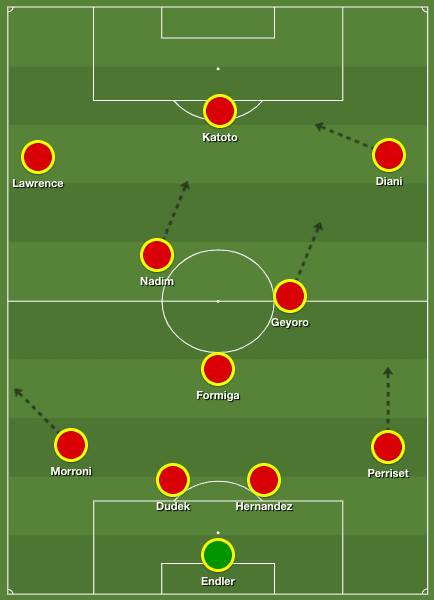
Most often, Nadia Nadim slots into the last midfield spot. However, she is given the freedom to move forward at her will, which creates the 4-4-2 or 4-2-4 structure we can often see from this PSG side. She works slightly behind the number nine Marie-Antoinette Katoto and makes runs depending on her movement, and where space opens up. Above you are able to see PSG’s typical 4-3-3 structure, along with their typical movements when in possession. This leads to the set-up we see in the image below. Here you can see Nadim’s advanced position as a secondary striker. She drifts freely, but as we will talk about a little later, she can have a tendency to move towards the right side. Reacting to this movement, the other two central midfielders shift to the left. Formiga holds the deepest position right in front of the defence. As well, we can see the right-back’s forward movement and the left-back dropping beside the centre-halves to compensate for this.
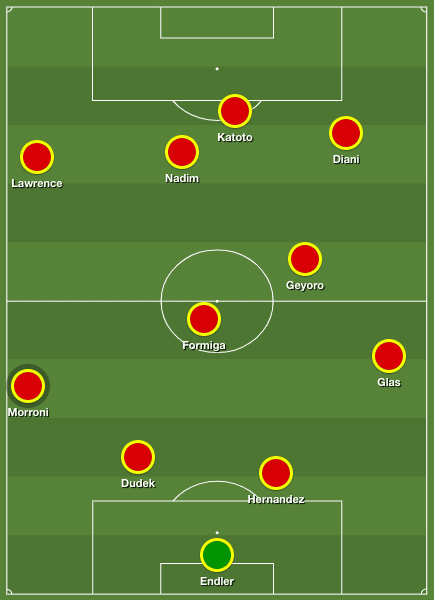
Defensive set-up
Defensively, PSG are very effective at sitting in a low block and waiting for opportunities to dispossess the opposition before moving into their attacking transition. Typically, we will see this set up in a 4-5-1, but we can also see this in a 5-4-1. One of the side’s greatest strengths in this area is their central players’ ability to transition in between different positions. We can commonly see one of the centre-halves stepping up into the midfield to carry out a specific pressing pattern, or a central midfielder such as Formiga dropping in between the centre-halves to form a back three. This allows PSG to have a lot of options in terms of being able to use a player-orientated or zonal marking system.
PSG’s high pressing scheme is highlighted by their passes per defensive action (PPDA) stat. The second-place team has been averaging a 5.34 PPDA. Compared to their French rivals Lyon of 6, and other top European sides like Wolfsburg at 7.06 and Arsenal at 7.93, this represents the side’s emphasis on regaining possession at the earliest possible opportunity.
PSG can also be very specific when it comes to their pressing scheme. Typically, PSG look to quickly find numerical superiorities and win possession back to look to counter down the channels. The wingers are very willing to drop into deep positions to help their full-back, often creating situations where they win back possession by isolating the opponent’s winger in these areas.
This tactic is deployed as it is the most secure area to send players into pressing situations. If the pressing side overcommits to a press that is played through, they are in an area of the pitch that it is possible to recover from, rather than a place such as in the centre where a lack of protection ahead of the defensive line could be extremely costly.
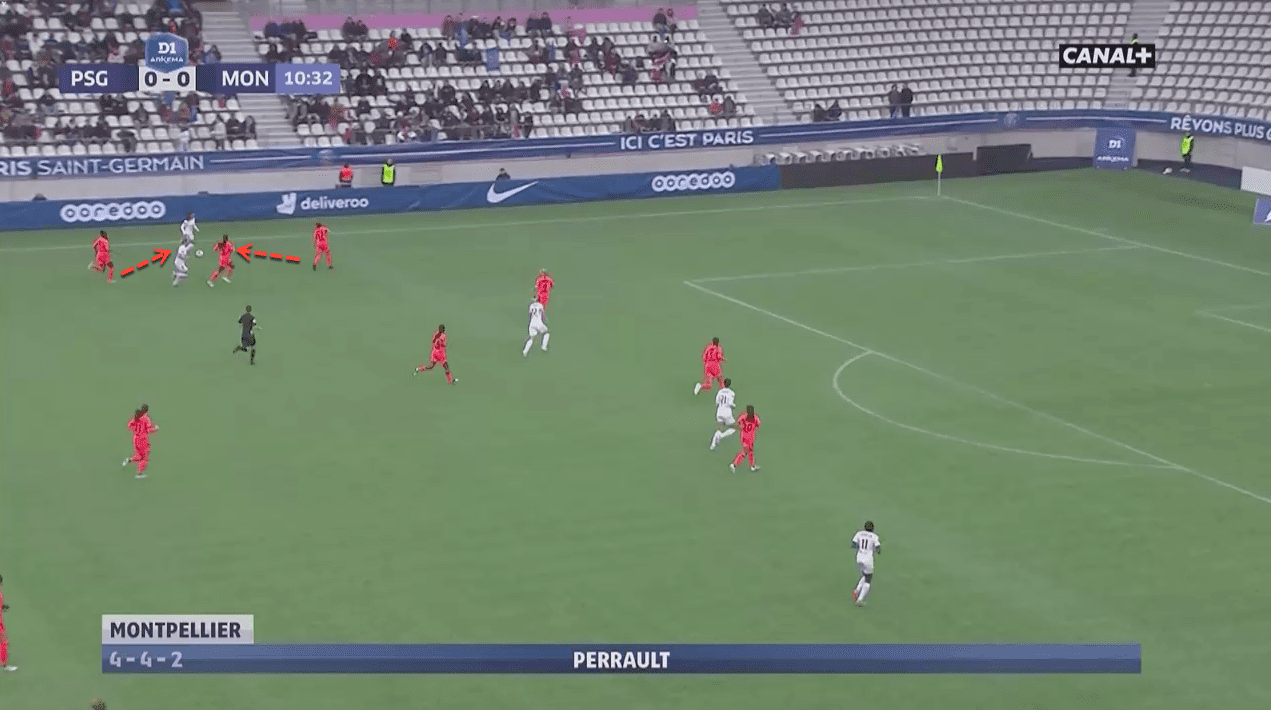
Above you can see a situation as we have described above. PSG have set up in their defensive structure and encouraged Montpellier to move into the wide area of the pitch. Once possession reaches this spot, the player on the ball takes her space as she looks for options ahead of her. As soon as she moves forward, the PSG winger tracks back very aggressively. When she does this, it triggers her full-back to push forward in an attempt to outnumber the attacking player and take away her options to continue the attacking move.
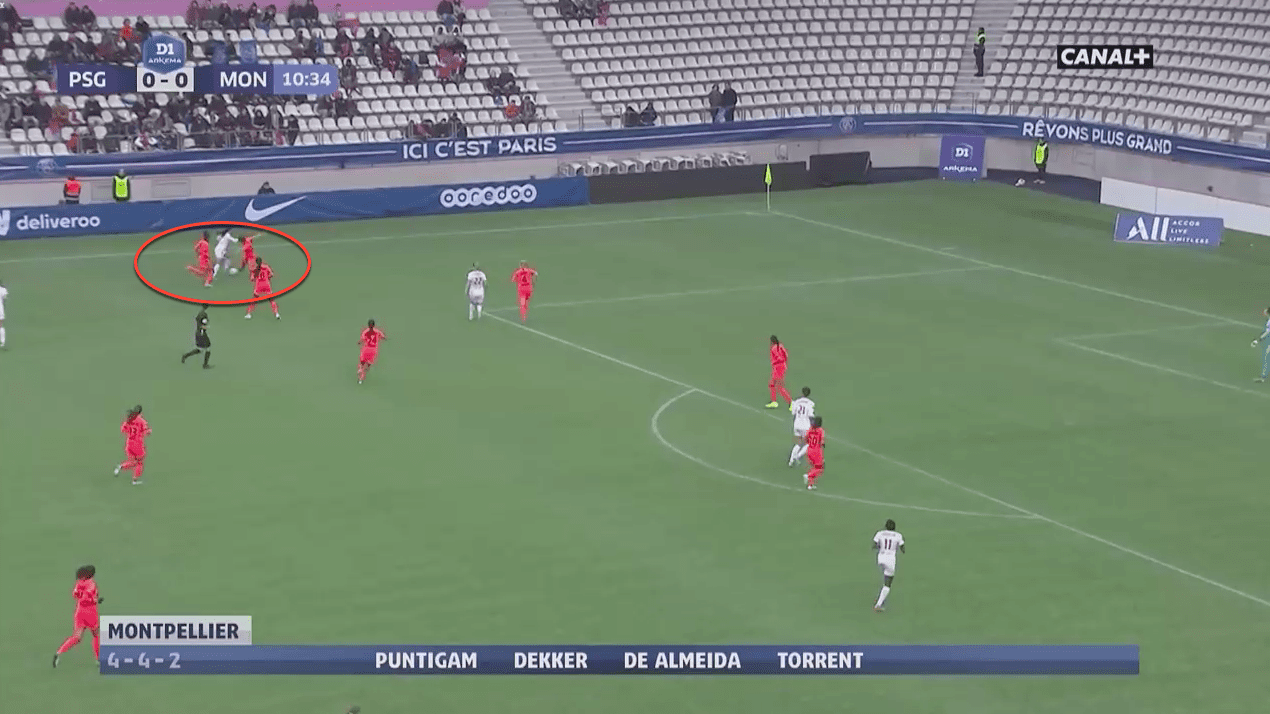
As you can see, the result of this press is a success, and PSG are able to turn this defensive situation into a quick counter-attack with numbers.
Issues: transitions
Moving forward, PSG has built a solid foundation for a side that can look to challenge Lyon in years to come. However, there is still work to be done before they can be classified as being part of that top tier of women’s football clubs around the world. We have looked at how PSG set up their side in attack and defence. Our focus is now going to shift to where the side can look to improve their game in to reach this next level.
Clubs often separate their tactics into four categories of a match: in possession, out of possession, possession lost, and possession gained. The previous two sections detailed a lot of PSG in the initial two categories above. One of their problems as this season has progressed has come from one of the latter two, in possession being lost. Because of the attacking set-up implemented by the French side, they are often left susceptible to counter-attacks.
There are multiple factors to account for this issue we have seen from PSG. We have seen a prime example of this in the mainstream media with Pep Guardiola’s Manchester City side. The defending English champions have been severely susceptible to getting caught out on the break this season, and a major reason behind this is the number of players pushed forward in attack.
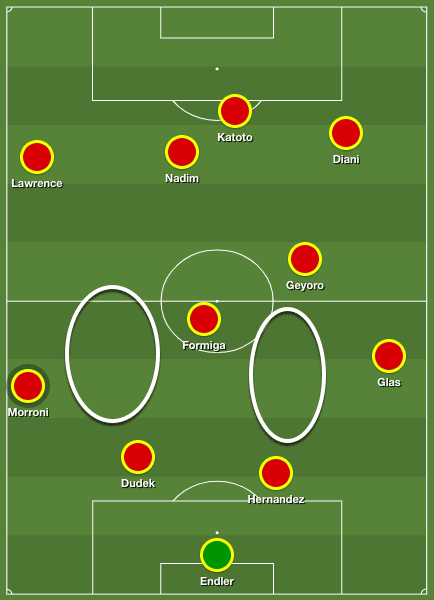
Above you can see PSG’s attacking structure as we discussed earlier in this piece. However, this image highlights the areas PSG have been caught off most often during this campaign. When the French side is attacking, the front five players look to take very advanced positions in attempts to try and break down what are often deep blocks set by the opposition. Additionally, the right-back is given the freedom to move forward to combine with the attacking players for a majority of matches when PSG are in possession. This leaves four players left to defend against counter-attacks, which can leave this space in abundance.
One specific issue we have seen during this campaign has been a lack of protection for the defensive line. Formiga has fantastic abilities that are essential to the side, but at 41 years of age, she is not as mobile as other lone defensive pivots in the world. This allows teams to look to play around her once possession is regained, and we have seen in matches such as against Bordeaux and Montpellier, golden opportunities can be gained from this. Defensive cover from the left-back would also aid in easing the burden on the Brazilian. In the first image we see below, PSG are working possession forward in their initial build-up structure. As they do this, Bordeaux are quick to look for an opportunity to press and find on from a lazy pass in midfield.
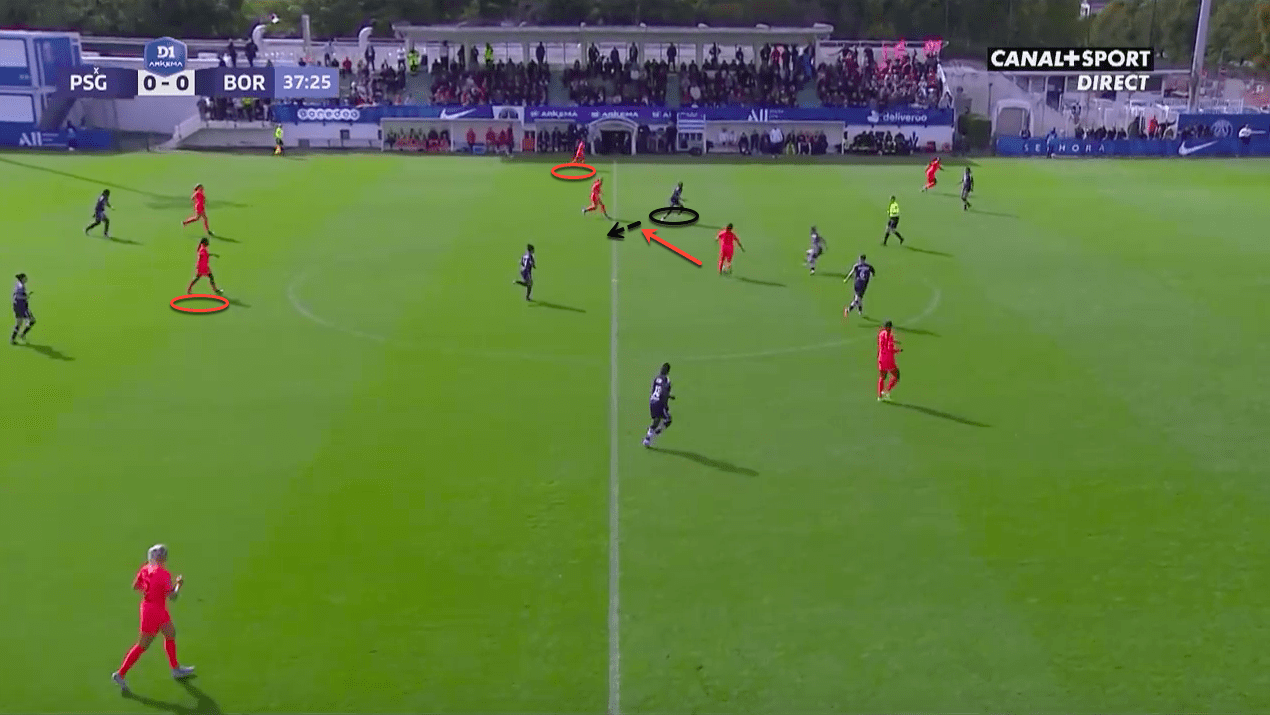
The Bordeaux attacker springs forward onto the ball, and PSG’s players are left scrambling to track back into position. Their set-up highlights the gaps they leave open when in possession. The full-back has taken a high position and is unable to track backward. As well, Formiga’s positioning leaves her unable to shift over to block the counter from continuing.
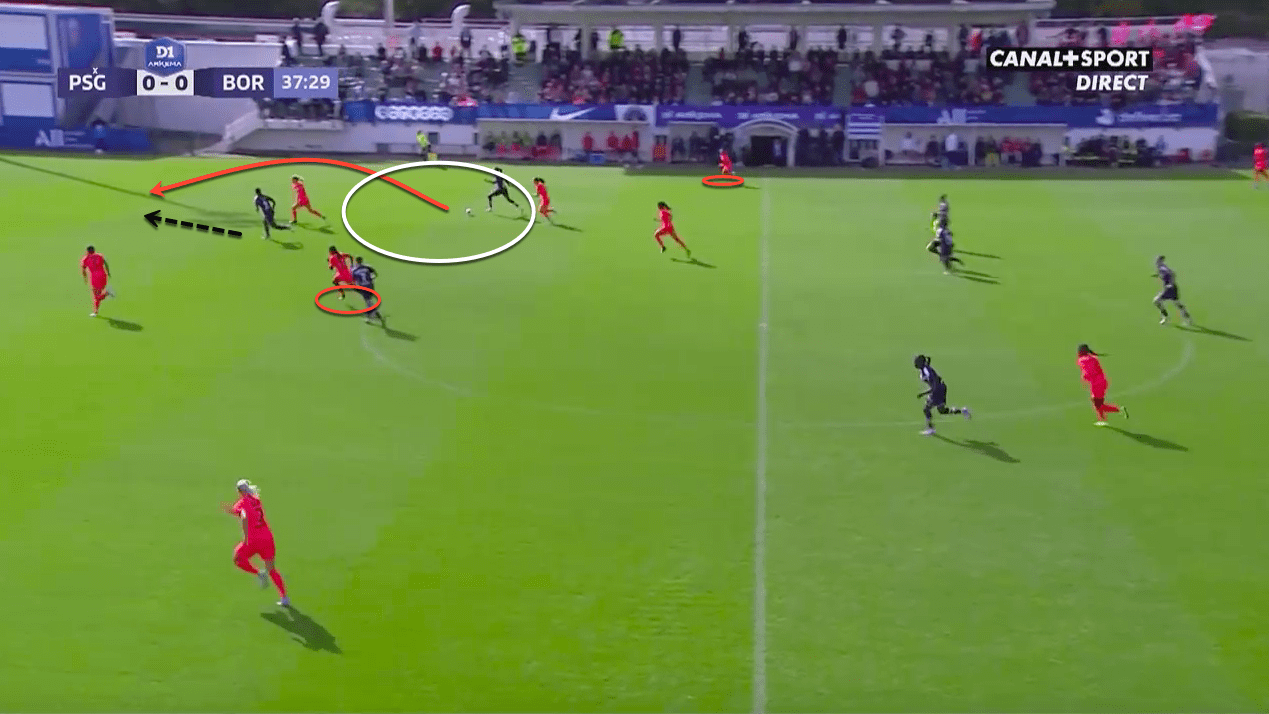
Another issue comes in the other transition phase of the game: possession gained. When PSG win back the ball and look to set up in their possession-based structure, they have a tendency to make rash passes that can lead to mistakes and counter-attacking opportunities for the opposition.
PSG’s centre-halves like to look for vertical passes as they move up the pitch. While this has the potential to open up the game in some cases, they are also very risky passes at times. In their match against Montpellier, the opposition used cover shadows brilliantly to intercept these types of passes on multiple occasions. In the image below we can see Pauline Dudek in possession of the ball in her own half. She sees the pass upfield to her left-winger. However, the opposition defender identifies this threat as well and makes a run in front of the attacker to intercept the pass.
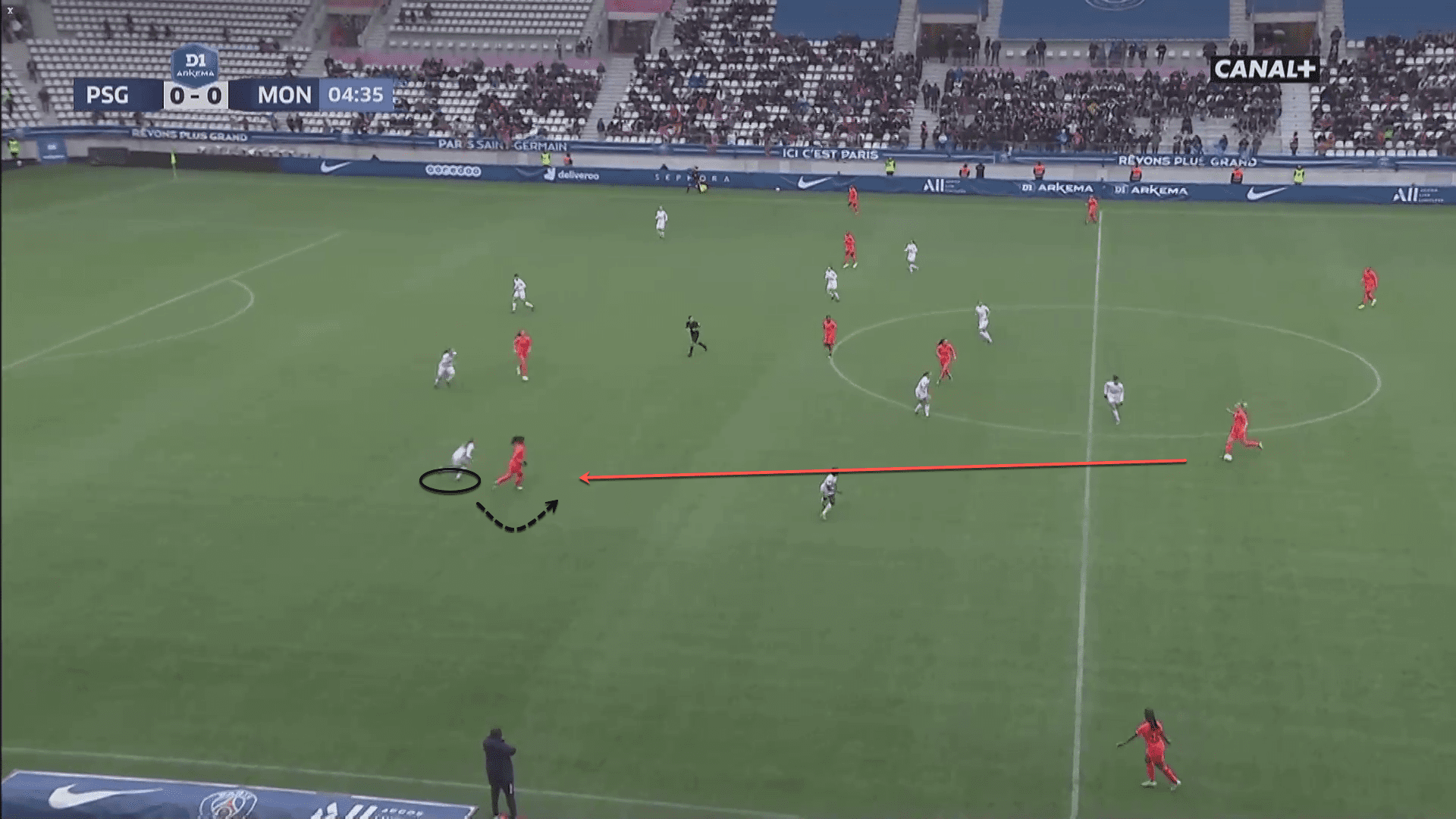
After dispossessing the PSG build-up, they are caught out of position. Quickly, Montpellier is able to move forward and attack with numbers. Below you can see the attacking opportunity that has come from this poor forward pass.
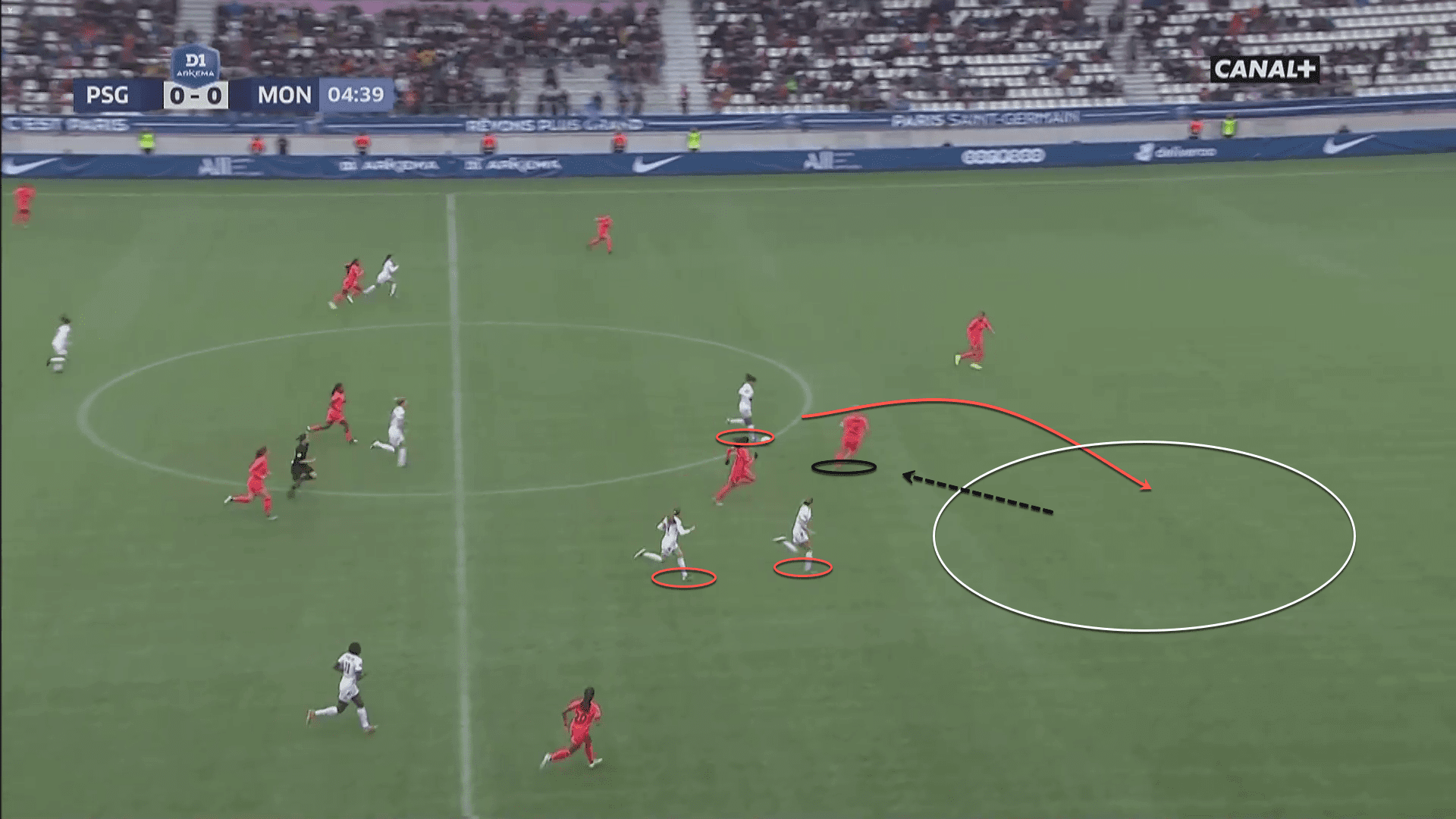
Both of these issues present issues relating to both tactics and personnel. Tactically, PSG must be better set up to deal with counter-attacks. This could be accomplished by adding an inverted full-back to their initial set-up. This would give the cover PSG need to either stop counter-attacks or hold them up until they can gain their defensive shape. Abdullah’s piece will be looking at the personnel alternatives that could better suit these tactics as well.
Issues: left-side productivity
On the attacking side of this PSG side, it is very evident where their most potent threats come from. The overwhelming majority of the time, the French side use the right side or through the middle to try and attack their opponents. Below you are able to see a positional attack chart from PSG’s match against Lyon. Not only did PSG use the right for double the number of attacks as the left, but they were also more successful with them.
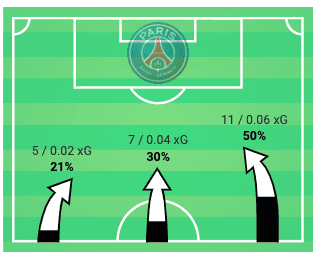
When we break down PSG’s structure, we are able to see the reasons behind this. When setting up in their attacking system we spoke on earlier, efforts are made to bolster the centre and right side of the pitch. However, this comes at the expense of the left side. In the centre of the pitch, this comes from the role Nadim is given. When PSG play in their 4-3-3, she takes up the left number eight role. In reality, though, she is much more of a secondary striker, playing extremely high up the pitch off of the number nine. With this, it creates a lack of a connection point between the side and PSG’s left-winger. Compounding this, PSG’s tendencies to attack down the right side of the pitch brings Nadim over to this side in order to get involved. So even in her advanced position, we will often see her drifting over to get involved in the play, further isolating the left side.
Looking deeper into the average positioning and pass maps from PSG matches, we see this tendency again. Two specific matches analysed highlight this issue in different ways. In the first pass map you can see below in PSG’s 3-0 win against Bordeaux, they lined up in a 4-3-3. For much of the first half, PSG struggled to break down Bordeaux’s defensive structure, before a scoring two goals right before halftime. However, for much of the half, it was the away side that generated the majority of the opportunities, including one that went off the crossbar. Nadim started the match at left-wing but given her typical tendencies, she pressed into the middle of the pitch to get involved in the play. This left the left side empty for much of the match, and limited PSG’s attacking potential in this area.
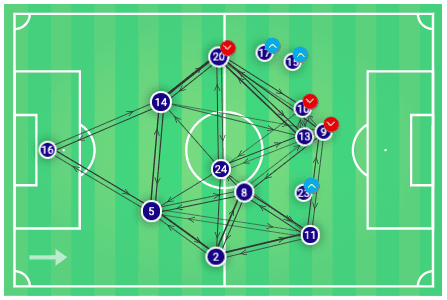
The second shows an example of PSG playing with a traditional winger on this side. Baltimore started this match in this position but was unable to make an impact in her sides 3-1 win over Stade de Reims. In this pass map, you can see the disconnect between Baltimore and the rest of her side. This is in stark contrast to the right side of the pitch, where you are able to see Diani being very closely supported by Geyoro in midfield. Due to this, the winger was allowed to come in and get much more involved in the match, getting on the scoresheet herself.
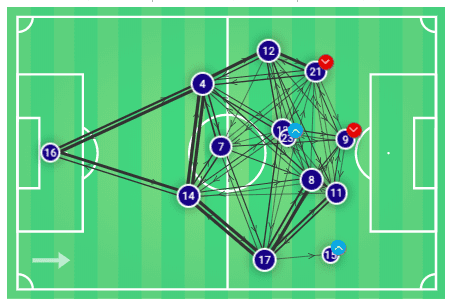
The other tactical dynamic that effects this is with the full-backs. PSG give their right-back the freedom to use her attacking abilities to get forward as often as possible. To compensate for this, the left-back is often staying back to better protect against counter-attacks. This creates a massive separation again between the two left-sided players and limits the opportunities for the left-back to move forward and connect with the left-winger.
Conclusion
As we head into the final stretch of the season, the Division 1 title race is nicely poised to provide an entertaining finish. All eyes will undoubtedly be on the Round 17 match on March 14th as PSG host Lyon. With three points separating the sides, a win or draw for Lyon could all but seal the title for them. However, a win for PSG would put them level on points and could make goal differential a massive factor down the stretch. Lyon leads their rivals by eight in this category – 58 to 50 – but with PSG’s attacking ability they cannot be underestimated.
Looking ahead for PSG, there are areas in the side which they can and should look to improve upon. Abdullah’s two-part series coming out today and next weekend will dive into these areas we have discussed in this piece and using data to find the specific players that could accomplish this.






Comments